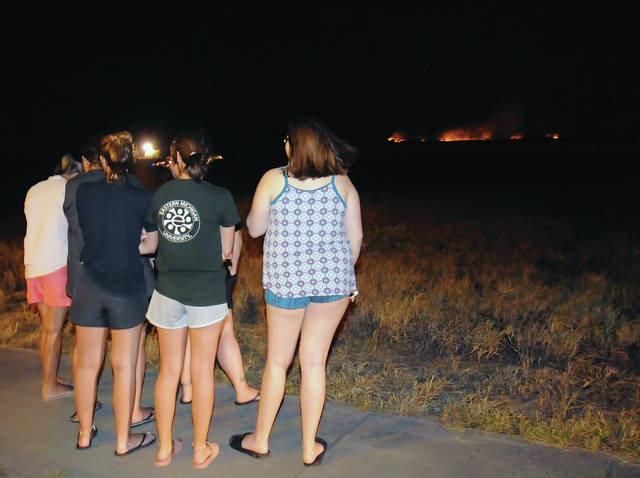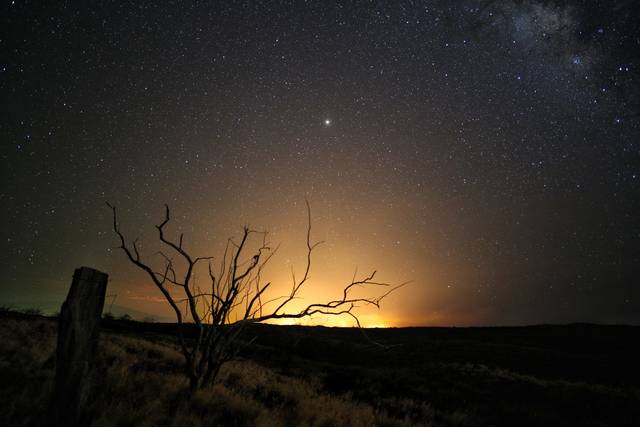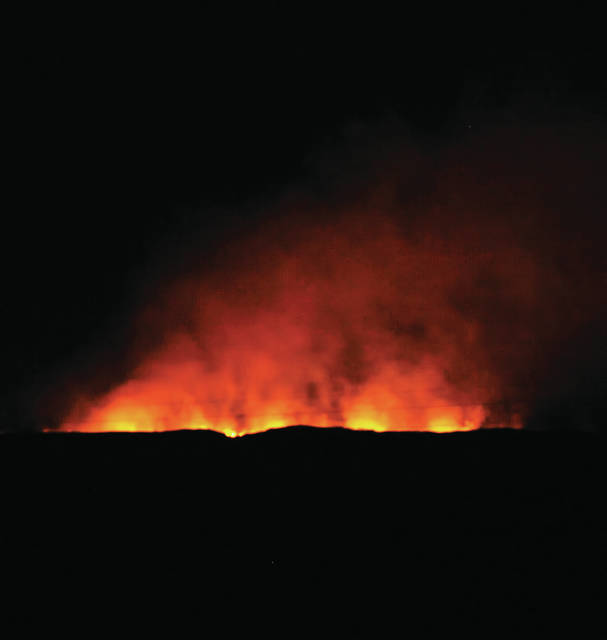WAIKOLOA — Waikoloa Village residents agreed emergency responders worked hard to protect their homes from an 18,000-acre brush fire that raged near their properties in August.
During a forum with police, fire, Civil Defense and other nonprofit volunteer groups at Waikoloa School Thursday evening, community members raised issues with how the blaze was handled by authorities, but two were prevalent. One was dissemination of information on the incident to the public was lacking and two: access to an evacuation road if Waikoloa Road was to close.
“There was nowhere for me to get information about where the fire was,” one Waikoloa Village resident said.
The 72-year-old woman added all county offices were closed and she couldn’t get anyone on the phone.
“I’m an old lady. I don’t wake up easily, but a fire outside my house might do it. So I spent the rest of the night preparing my pickup truck to bug out,” she said. “It’s not fair to do that to my old heart. It’s not worth it to agitate citizens like that. It’s pointless.”
The Waikoloa fire ignited in the afternoon on Aug. 1 and burned for a week. The cause is still undetermined.
Elizabeth Pickett, executive director for Hawaii Wildfire Management Organization, explained the Waikoloa area is one of the most fire-prone areas on the island due to the topography and vegetation.
During the forum, firefighters explained what their plan of action was and the communication they had with Civil Defense, Hawaii Police and Pohakuloa Training Area.
Hawaii Fire Capt. Bill Bergin explained to the group in the school cafeteria that he was in Waimea at the time.
“With the winds, it took the fire directly toward Waikoloa,” Bergin said. “Our primary objective right off the bat was to keep the fire away from Waikoloa Village and to keep it below (Highway) 190.”
That first day, firefighters didn’t have enough resources to fight the blaze. Dozers didn’t make it to the scene until four or six hours into the fire’s burn.
Capt. Michael Grace talked about how fire breaks were created between the fire and village the night of the fire.
“Our primary goal is to protect life and property,” Grace said.
The fire never got to a point where firefighters felt an evacuation order was needed.
Fire Chief Darren Rosario said the work of the firefighters on the wildfire was excellent due to the fact that it was mitigated within a week without injuries or property loss.
“My hats off to all the men and women working from all the agencies,” Rosario said.
The chief added the incident commander the day of fire recognized the severity of the conditions right away with the high winds and contacted the Emergency Operations Center with Civil Defense. At that point, the incident management team mobilized.
Several of the community members spoke about their concerns after forum speakers talked about what went well during the Waikoloa blaze and what could be done differently.
Jen Lawson, executive director of the Waikoloa Dry Forest Initiative, commended the agencies for their good internal communication, however that communication was not translated to the community.
“Communication with stakeholders is important,” Lawson said. “We need to know we’re being heard.”
Almost a mile of fencing, costing about $57,000 around the Dry Forest Preserve, was destroyed in the fire, as well as 24 acres of land within the reserve.
Lawson told the forum speakers that she wants them to think of the community and stakeholders as an asset and resource.
“One way I think we could be better is getting those bulldozers our there faster,” she said. “We need to have bulldozers stationed here.”
Waikoloa Village resident Loretta Robinson said the misinformation on social media was amazing, adding her regular phone alerts through Civil Defense and HPD’s Nixle provided the information she needed.
While the fire got close, firefighters that spoke at the forum said, the flames never got so close they felt an evacuation order was needed. One resident took issue with that. Richard Apothaker said the blaze was too close for comfort.
“What you’ve done is remarkable — but it’s unacceptable,” he said. “I decide when I evacuate.”
Apothaker added he would like to know what his resources are on how to defend his property.
“Help us defend ourselves,” he said. “You do what you do, let us know what we can do.”
After the forum, Apothaker’s wife Lee said she was glad she had the opportunity to meet with county officials.
“I appreciated their warmth and information,” she said. “The communication was great tonight. They listened to us.”
In the event that the road in the village closes, residents voiced concerns about access to the one evacuation road locked behind a gate. Also, the drivability of the road was called into question.
Officials assured residents that the road is rough but two-wheel drive capable. Officials also said there are a few people who have a key to the gate but that they would make sure that wasn’t an issue.
During the forum, Pickett explained there are ways residents can pre-fire plan by doing vegetation management around their properties. Waikoloa Village is the largest certified firewise community in the state.
Rosario appreciated the opportunity to meet with the community.
“Anytime we can get constructive criticism is a good thing,” the chief said. “We’re busy on the line trying to mitigate fires. The ability to address communication concerns face to face is immeasurable.”









Might be worthwhile for the resident to really look into wildfire landscaping, both individually and as a community. There’s a whole science to that, many resources available, especially based on California’s long-term experience.
Maybe wildfire landscaping could also be dovetailed with restoration efforts, from both ecological and/or culturo-historical perspectives. A restored native dryland forest might provide only marginal protection as a wildfire buffer zone… but perhaps restoration of the sweet potato and dryland taro that were once grown in that general area might provide some degree of protection, as well as a usable crop… ?